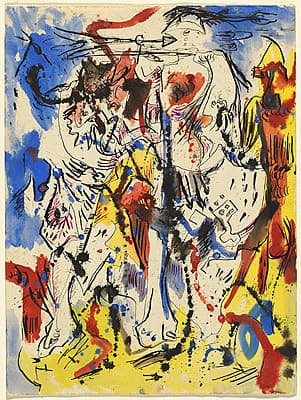
Jackson
POLLOCK
United States of America
1912
–
1956
Untitled
c.1944
watercolour, ink, gouache
on paper
OT 985
no inscriptions
sheet
40.6 (h)
x 30.4 (w)
cm
Purchased 1985
National Gallery of Australia, Canberra
NGA 1985.226
© Pollock/Krasner Foundation/ARS. Licensed by Viscopy
- estate of the artist, from c.1944 to 1957;
- with Lee Krasner Pollock, from 1957 to c.1961;
- with Marlborough Fine Art Ltd, London, from c.1961 to c.1964;
- with Dr Joseph Goldyne, San Francisco, from c.1964 to 1982;
- with Hirschl and Adler Modern, New York, from November 1982 to 1985;
- from whom bought by the Australian National Gallery, February 1985
- Drawings by Jackson Pollock
- Sidney Janis Gallery 04 Nov 1957 – 30 Nov 1957
- Jackson Pollock: Paintings, Drawings and Watercolours from the Collection of Lee Krasner Pollock
- MARLBOROUGH FINE ART 1961-06- – 1961-06-
- Jackson Pollock
- Kunsthalle, Dusseldorf 05 Sep 1961 – 08 Oct 1961
- Jackson Pollock
- Kunsthalle, Zurich 24 Oct 1961 – 29 Nov 1961
- Jackson Pollock
- Marlborough Galleria d'Arte, Rome 1962-10- – 1962-11-
- Jackson Pollock
- Toninelli Arte Moderno, Milan 1962-11- – 1962-12-
- Jackson Pollock
- Marlborough - Gerson Gallery Inc., 1964-01- – 1964-02-
- Six Painters
- University of St Thomas 1967-02- – 1967-04-
- Jackson Pollock: Drawing into Painting
- MUSEUM OF MODERN ART 01 Apr 1979 – 13 May 1979
- Stõdtische Kunsthalle, Dusseldorf 10 Jun 1979 – 22 Jul 1979
- Directora do Museu Gulbenkian 1979-08- – 1979-09-
- Musee d'Art Moderne de la Ville de Paris 26 Sep 1979 – 18 Nov 1979
- Stedelijk van Abbemuseum 01 Dec 1979 – 20 Jan 1980
- Museum of Modern Art, New York 04 Feb 1980 – 16 Mar 1980
- Jackson Pollock's Blue poles
- National Gallery of Australia 04 Oct 2002 – 27 Jan 2003
- Controversy: the power of art
- Mornington Peninsula Regional Gallery 21 Jun 2012 – 12 Aug 2012
- Abstract Expressionism: the National Gallery of Australia celebrates the centenaries of Jackson Pollock and Morris Louis
- 14 Jul 2012 – 24 Feb 2013
- Drawings by Jackson Pollock, New York: Sidney Janis Gallery 1957, cat. 19;
- Jackson Pollock; paintings, drawings and watercolours from the collection of Lee Krasner Pollock, London: Marlborough Fine Art 1961, cat. 22, illus. (work dated late 1930s with reservation);
- Kunsthalle, Jackson Pollock, Düsseldorf 1961, cat. 33, illus. (dated c. 1938);
- Kunsthalle, Jackson Pollock, Zurich 1961, cat. 33, illus. (dated c. 1938);
- Marlborough Galleria d’Arte, Jackson Pollock, Rome 1962, cat. 16, illus. (dated c. 1938); Toninelli Arte Moderno, Jackson Pollock, Milan 1962, cat. 16, illus. (dated c. 1938);
- Marlborough-Gerson Gallery, Jackson Pollock: Black and white, New York 1969, cat. 52, illus. (dated c. 1938);
- University of St. Thomas, Six painters, Texas 1967, cat. 43;
- Eugene Thaw & Francis O’Connor, Jackson Pollock: Catalogue raisonne of paintings, drawings and other works, New Haven and London: Yale University Press 1978, cat. 985, p. 61, b&w illus. (image upside down);
- International Council of the Museum of Modern Art, Jackson Pollock: drawings into painting, New York 1979, p. 94 (listed)
- Anthony White (ed.), Jackson Pollock’s Blue poles, Canberra: National Gallery of Australia 2002, cat. 26, p. 118, illus. col. p. 101;
Rendered in a restless, black ink line, a horse and its rider emerges as the central image of the drawing Untitled. The rider wears a helmet that is adorned with feathers, or perhaps tassels, whilst the horse strides from right to left across the picture plane, with stark white forelegs and solid hoofs. An arrow or compass element is placed top and centre as an omen, perhaps, warning the rider that he is moving closer to his demise: travelling towards pictorial disintegration. The abstract background is a tangle of undefined areas of blue and yellow applied in loosely brushed formations; spiky black ink splashes; and erratic red highlights. It is difficult to distinguish the horse and its rider from its heavily worked backdrop—the figurative subject matter is almost completely absorbed by the energetic activity of the background.
The image of a horse and rider was one that Pollock had taken up in several earlier drawings. In this case, however, the subject is specifically derived from Pablo Picasso’s 1937 etching The dream and lie of Franco, a multi-panelled political narrative that depicts the Fascist General Franco riding a wild, eviscerated horse. Picasso’s etching is illustrated in an elaborate expressionistic style, employing the full gamut of linear possibilities that are uniquely afforded by this printmaking technique. Pollock’s shared fascination with the linear and his commitment to the progress of painterly techniques is explored on similar terms in this drawing.
From a retrospective viewpoint, we can read Pollock’s use of spatter and drip-like application of ink as an allusion to what was to come in his future work. In this way, Untitled displays Pollock’s transition toward a mature style, a style that was to be celebrated for its ‘over-all’ compositional structure and for the triumph of the abstract over the figurative.
Jaklyn Babington
As well as the two paintings by Pollock, Totem lesson 2 1945 and Blue poles 1952, the National Gallery of Australia holds six drawings from the 1930s and 1940s, and two sets of prints; six intaglio prints c. 1944, printed 1967, and six screenprints 1950.
